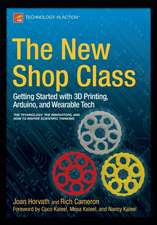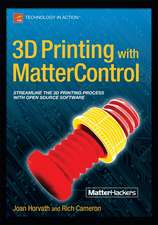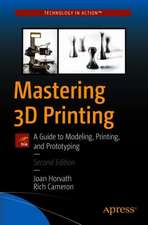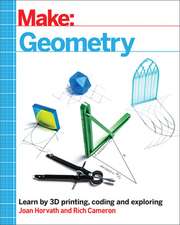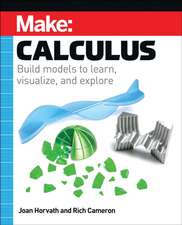3D Printed Science Projects Volume 2: Physics, Math, Engineering and Geology Models
Autor Joan Horvath, Rich Cameronen Limba Engleză Paperback – 24 mai 2017
Learn physics, engineering, and geology concepts usually seen in high school and college in an easy, accessible style.
This second volume addresses these topics for advanced science fair participants or those who just like reading about and understanding science. 3D Printed Science Project Volume 2 describes eight open-source 3D printable models, as well as creative activities using the resulting 3D printed pieces. The files are designed to print as easily as possible, and the authors give tips for printing them on open source printers.
As 3D printers become more and more common and affordable, hobbyists, teachers, parents, and students stall out once they've printed some toys and a few household items. To get beyond this, most people benefit from a “starter set” of objects as a beginning point in their explorations, partially just to see what is possible. This book tells you the solid science stories that these models offer, andprovides them in open-source repositories.
This second volume addresses these topics for advanced science fair participants or those who just like reading about and understanding science. 3D Printed Science Project Volume 2 describes eight open-source 3D printable models, as well as creative activities using the resulting 3D printed pieces. The files are designed to print as easily as possible, and the authors give tips for printing them on open source printers.
As 3D printers become more and more common and affordable, hobbyists, teachers, parents, and students stall out once they've printed some toys and a few household items. To get beyond this, most people benefit from a “starter set” of objects as a beginning point in their explorations, partially just to see what is possible. This book tells you the solid science stories that these models offer, andprovides them in open-source repositories.
What You Will Learn
- Create (and present the science behind) 3D printed models
- Review innovative ideas for tactile ways to learn concepts in engineering, geology and physics
- Learn what makes a models easy or hard to 3D print
Who This Book Is For
The technology- squeamish teacher and parents who want their kids to learn something from their 3D printer but don’t know how, as well as high schoolers and undergraduates.
Preț: 153.84 lei
Preț vechi: 192.30 lei
-20% Nou
Puncte Express: 231
Preț estimativ în valută:
29.44€ • 31.97$ • 24.73£
29.44€ • 31.97$ • 24.73£
Carte disponibilă
Livrare economică 02-16 aprilie
Preluare comenzi: 021 569.72.76
Specificații
ISBN-13: 9781484226940
ISBN-10: 1484226941
Pagini: 181
Ilustrații: XVIII, 181 p. 87 illus., 82 illus. in color.
Dimensiuni: 155 x 235 x 13 mm
Greutate: 0.29 kg
Ediția:1st ed.
Editura: Apress
Colecția Apress
Locul publicării:Berkeley, CA, United States
ISBN-10: 1484226941
Pagini: 181
Ilustrații: XVIII, 181 p. 87 illus., 82 illus. in color.
Dimensiuni: 155 x 235 x 13 mm
Greutate: 0.29 kg
Ediția:1st ed.
Editura: Apress
Colecția Apress
Locul publicării:Berkeley, CA, United States
Cuprins
Chapter 1. Pendulums.- Chapter 2. Geology.- Chapter 3. Snow and Ice.- Chapter 4. Doppler and Mach.- Chapter 5. Moment of Inertia.- Chapter 6. Probability.- Chapter 7. Digital Logic.- Chapter 8. Gravitational Waves.- Appendix A. 3D Printing and OpenSCAD.- Appendix B. Links.
Notă biografică
Joan Horvath:
As an engineer and management consultant, Joan Horvath has coordinated first-of-a-kind interdisciplinary technical and business projects, helping people with no common vocabulary (startups, universities, small towns, etc). work together. Her experience as a systems engineer has spanned software development, spacecraft flight operations, risk management, and spacecraft/ground system test and contingency planning.As an educator, Joan’s passion is bringing science and technology to the non-specialist in a comprehensible and entertaining way that will stay with the learner for a lifetime.
As an educator, Joan’s passion is bringing science and technology to the non-specialist in a comprehensible and entertaining way that will stay with the learner for a lifetime.
Rich Cameron:
Rich Cameron is a cofounder of Pasadena-based Nonscriptum LLC. Nonscriptum consults for educational and scientific users in the areas of 3D printing and maker technologies. Rich (known online as "Whosawhatsis") is an experienced open source developer who has been a key member of the RepRap 3D-printer development community for many years. His designs include the original spring/lever extruder mechanism used on many 3D printers, the RepRap Wallace, and the Deezmaker Bukito portable 3D printer. By building and modifying several of the early open source 3D printers to wrestle unprecedented performance out of them, he has become an expert at maximizing the print quality of filament-based printers. When he's not busy making every aspect of his own 3D printers better, from slicing software to firmware and hardware, he likes to share that knowledge and experience online so that he can help make everyone else’s printers better too.
Textul de pe ultima copertă
Learn physics, engineering, and geology concepts usually seen in high school and college in an easy, accessible style.
This second volume addresses these topics for advanced science fair participants or those who just like reading about and understanding science. 3D Printed Science Project Volume 2 describes eight open-source 3D printable models, as well as creative activities using the resulting 3D printed pieces. The files are designed to print as easily as possible, and the authors give tips for printing them on open source printers.
As 3D printers become more and more common and affordable, hobbyists, teachers, parents, and students stall out once they've printed some toys and a few household items. To get beyond this, most people benefit from a “starter set” of objects as a beginning point in their explorations, partially just to see what is possible. This book tells you the solid science stories that these models offer, and provides them in open-source repositories.
This second volume addresses these topics for advanced science fair participants or those who just like reading about and understanding science. 3D Printed Science Project Volume 2 describes eight open-source 3D printable models, as well as creative activities using the resulting 3D printed pieces. The files are designed to print as easily as possible, and the authors give tips for printing them on open source printers.
As 3D printers become more and more common and affordable, hobbyists, teachers, parents, and students stall out once they've printed some toys and a few household items. To get beyond this, most people benefit from a “starter set” of objects as a beginning point in their explorations, partially just to see what is possible. This book tells you the solid science stories that these models offer, and provides them in open-source repositories.
Caracteristici
Provides exciting advanced projects for hobbyists Provides the open-source models with the book Uses a more advanced and sophisticated scientific approach while keeping explanations clear for the general public adult or advanced younger student






